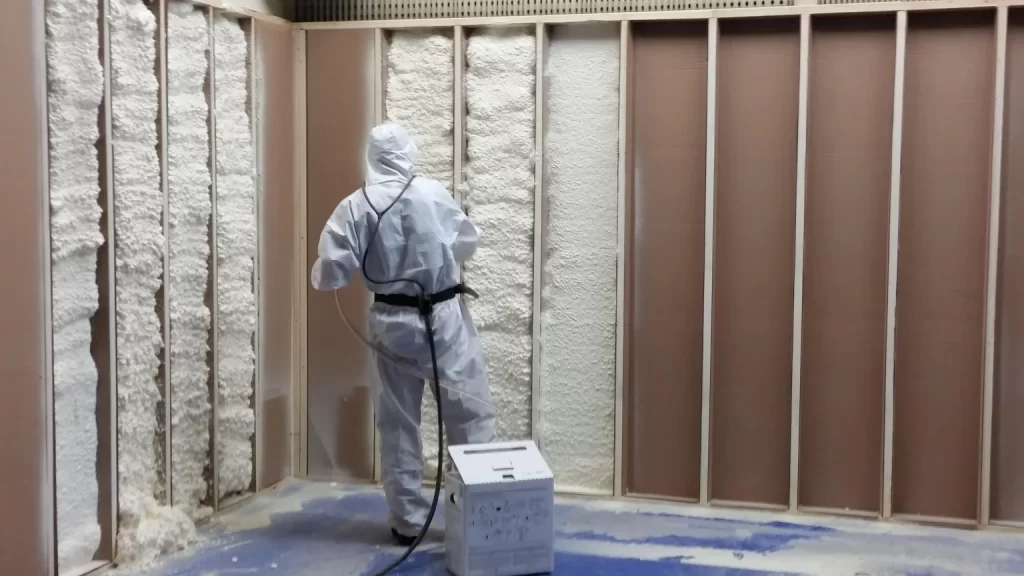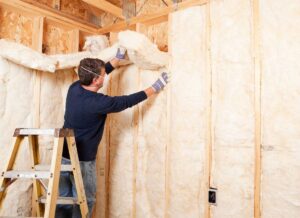Proper wall insulation significantly lowers energy bills for homeowners in Cary, NC. Given the region’s humid subtropical climate, with hot summers and mild winters, homes experience consistent pressure on their HVAC systems. Insulating walls minimizes unwanted heat transfer, stabilizes indoor temperatures, and reduces dependence on heating and cooling appliances.
In many cases, wall insulation services alone can reduce heating and cooling costs by up to 15% annually. This article outlines exactly how, using clearly organized facts, comparisons, and technical data. Whether you’re renovating, upgrading, or building new, understanding insulation’s impact on energy use is essential for smarter decisions.
How Wall Insulation Impacts Energy Bills in Cary
Wall insulation functions by resisting heat flow through walls. In uninsulated or poorly insulated homes, heat easily moves through walls in both summer and winter. During summer, hot outdoor air infiltrates the home, and in winter, indoor heat escapes through exterior walls. This results in increased HVAC runtime and inflated utility bills.
Cary, located in Climate Zone 3A, demands a balanced insulation strategy. During peak summer months, insulation helps trap cool air indoors. In winter, it retains warmth, reducing the frequency and intensity of heater usage. Combined, these effects reduce monthly energy consumption and stabilize indoor comfort throughout the year.
Data from the U.S. Department of Energy shows that homeowners can save up to 15% on heating and cooling costs with proper wall insulation. In financial terms, that could mean $200–$600 per year for an average 2,000 sq. ft. home in Cary, depending on energy rates and home layout.
Types of Wall Insulation in Cary
Different wall insulation services in Cary, NC serve varying purposes depending on home age, structure, and energy goals. Choosing the right material ensures optimal thermal resistance and moisture control.
Batt Insulation
- Pre-cut panels typically made of fiberglass or mineral wool
- Fits between studs and joists in open wall cavities
- Best suited for new constructions or full renovations
Blown-In Insulation
- Loose-fill cellulose or fiberglass blown into wall cavities
- Ideal for retrofit applications
- Fills gaps and irregular spaces more effectively than batts
Foam Board
- Rigid panels made from polystyrene or polyisocyanurate
- Installed on exterior walls before siding
- Offers high R-value per inch and adds structural strength
Injection Foam
- Liquid foam injected into closed walls where batts or boards aren’t feasible
- Expands to fill air gaps, offering superior air sealing
- Excellent for older homes without tearing down drywall
Comparison of Wall Insulation Types
| Insulation Type | Material | R-Value per Inch | Best Use Case | Cost Range ($/sq.ft.) | Air Sealing Capable |
| Batt | Fiberglass/Wool | 2.9 – 3.8 | New builds, open-frame walls | 0.30 – 1.50 | No |
| Blown-In | Cellulose/Fibers | 3.2 – 3.8 | Retrofits, irregular cavities | 0.75 – 1.90 | Moderate |
| Foam Board | XPS/Polyiso | 4.5 – 6.5 | Exterior sheathing, new siding | 1.10 – 2.50 | No |
| Injection Foam | Polyurethane | 4.0 – 5.5 | Enclosed wall retrofits | 1.80 – 3.00 | Yes |
Technical Performance Specifications
Wall insulation materials are evaluated based on thermal, air, moisture, and fire performance. Each factor impacts energy efficiency and long-term durability.
| Property | Relevance in Cary | Ideal Value/Range |
| R-Value (Thermal Resistance) | Resists heat flow | R-13 to R-21 for exterior walls |
| Air Infiltration | Reduces HVAC load | Close to zero leakage |
| Moisture Resistance | Prevents mold in humid climate | High permeability or treated |
| Fire Resistance | Safety during high temperatures | Class A-rated materials |
| Lifespan | Impacts re-installation cycle | 20+ years with proper install |
Energy Trends in Cary Homes
Cary homes typically consume 25-35% of their energy on cooling during the summer. Without proper insulation, this figure can spike to over 45%. The North Carolina Clean Energy Technology Center notes that older homes built before 1990 often lack sufficient wall insulation, resulting in 30% higher energy costs compared to newer buildings.
A 2023 study by the National Renewable Energy Laboratory found that Southeastern homeowners, including those in North Carolina, see a 12–18% return on investment annually from insulation upgrades alone.
Things to Consider Before Making a Decision
Home Construction and Age
- Homes built before 1990 often lack adequate insulation or contain outdated materials
- Stud spacing, wall thickness, and existing insulation types must be evaluated before upgrades
Cary’s Climate Conditions
- Humid summers require vapor-permeable yet moisture-resistant insulation
- Winters are mild but require insulation to maintain heating efficiency
Wall Accessibility
- Open-frame walls allow for batt or board insulation
- Enclosed walls are better suited for blown-in or injection foam
HVAC Compatibility
- Insulation affects HVAC sizing
- Oversized units may short-cycle if insulation reduces load without recalibration
Code Compliance and Rebates
- Minimum R-Value for wall assemblies in Cary (Zone 3A) is R-13 for 2×4 walls or R-19 for 2×6 walls
- Check for rebates through Duke Energy or the NC Weatherization Assistance Program
Bonus Tip: Use a thermal imaging camera to identify insulation gaps and prioritize retrofit zones.
Common Questions About Wall Insulation in Cary
How do I know if my walls need insulation?
- Uncomfortable room temperatures
- High energy bills
- Drafts near walls
- Cold wall surfaces in winter
Can wall insulation fix uneven indoor temperatures?
Yes. Proper insulation distributes heating and cooling more evenly, eliminating hot or cold zones within rooms.
What’s the best insulation type for enclosed walls?
Injection foam and blown-in cellulose are ideal for enclosed walls since they don’t require removing drywall.
Do I need to remove existing insulation before adding new?
Only if the existing insulation is damaged, moldy, or waterlogged. Otherwise, adding insulation over older material is often acceptable.
Bonus Tip: Always test for wall moisture levels before installing new insulation to prevent mold.
How long does insulation last?
Most insulation materials last 20 to 30 years if undisturbed and protected from moisture or pests.
Topic FAQ
What R-value do Cary homes need for wall insulation?
Exterior walls in Cary should meet or exceed R-13 to R-21, depending on wall depth and material used.
Can I install wall insulation myself?
DIY is possible for batt and some blown-in types, but foam products and sealed-wall retrofits are best left to professionals.
Will insulation reduce both heating and cooling costs?
Yes. Insulation reduces the workload for both systems by maintaining interior temperature year-round.
How does moisture affect insulation?
In humid climates like Cary, moisture can degrade insulation performance and lead to mold growth. Moisture-resistant or vapor-permeable products are essential.
Is it worth insulating just one side of a wall?
Partial insulation reduces some energy loss but offers limited benefits. Full coverage delivers optimal savings.
Make the Right Decision
Wall insulation is a cost-effective way to improve energy efficiency and indoor comfort in Cary, NC. By reducing thermal transfer, insulation stabilizes room temperature, lowers energy bills, and extends HVAC lifespan. For homeowners in Cary’s climate, addressing wall insulation can lead to double-digit annual savings and greater comfort year-round.
Before installing or upgrading insulation, evaluate wall access, home age, budget, and energy goals. Use professional diagnostics if necessary, and choose materials that align with both building codes and the region’s humid subtropical conditions. Making an informed insulation decision today helps ensure reduced utility bills and consistent performance for decades.







